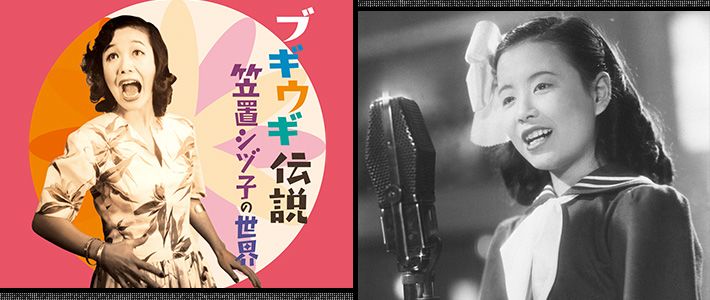
A Revisionist History of Postwar Pop
Society Culture- English
- 日本語
- 简体字
- 繁體字
- Français
- Español
- العربية
- Русский
“Our songs change with the times, and the times change with our songs,” goes the saying. In actual fact, the tenor of the times is rarely shaped by popular music. And it is open to question whether popular music directly reflects the spirit of the era. In retrospect, however, the two often seem inextricably linked. In the following survey of popular music in the early postwar era, we explore the ways in which certain songs and genres have come to epitomize the times in the collective memory of the Japanese people.
Apple Song: Wartime Origins of a Postwar Hit
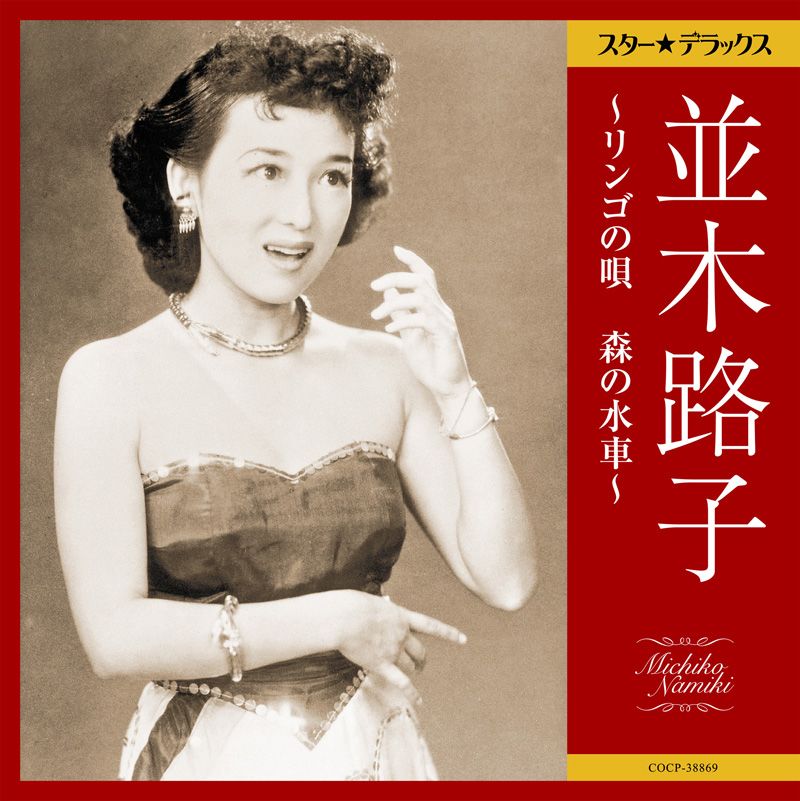 Namiki Michiko (1921–2011) as pictured on the cover of a recent release featuring her 1945 hit “Ringo no uta” (The Apple Song). Born in Tokyo’s Asakusa district, Namiki spent her early years in Taiwan. In 1936 she entered the training corps for the Shōchiku Shōjo Kagekidan, an all-female musical theater troupe, and the following year she launched a successful stage career with her debut at the Asakusa International Theater. During the war, Namiki traveled as far as Shanghai and the Philippines to entertain Japanese troops. Starring in the 1945 Shōchiku movie Soyokaze (A Gentle Breeze), she performed Manjōme Tadashi’s “Ringo no uta,” which became the first pop-music hit of the postwar era. (Nippon Columbia, 2014)
Namiki Michiko (1921–2011) as pictured on the cover of a recent release featuring her 1945 hit “Ringo no uta” (The Apple Song). Born in Tokyo’s Asakusa district, Namiki spent her early years in Taiwan. In 1936 she entered the training corps for the Shōchiku Shōjo Kagekidan, an all-female musical theater troupe, and the following year she launched a successful stage career with her debut at the Asakusa International Theater. During the war, Namiki traveled as far as Shanghai and the Philippines to entertain Japanese troops. Starring in the 1945 Shōchiku movie Soyokaze (A Gentle Breeze), she performed Manjōme Tadashi’s “Ringo no uta,” which became the first pop-music hit of the postwar era. (Nippon Columbia, 2014)
“Ringo no uta” (Apple Song, 1945) and “Tokyo Boogie Woogie” (1947) are perhaps the two best-known songs of the immediate postwar era, and to most people familiar with them, they seem to epitomize the carefree, liberated mood suffusing Japanese culture after the war’s end. Both were certainly huge hits in the years immediately following Japan’s surrender. But what people tend to forget is that both songs illustrate the continuity between the prewar or wartime years and the postwar era, and that in intellectual and progressive circles, the popularity of such songs was considered problematical.
“Ringo no uta,” known as the first popular hit of the postwar era, was composed for the movie Soyokaze (A Gentle Breeze), which was released in October 1945, just two months after Japan’s surrender. The movie and the song, in other words, were actually wartime productions. Toward the end of the war, the emphasis in filmmaking had shifted from the sentimental depiction of hardships on the home front to sheer feel-good entertainment that offered an escape from the privations of daily life. Soyokaze and “Ringo no uta” appear to have been conceived with this purpose in mind.
In Japan it had been standard practice to release recordings of movie theme songs ever since the commercial success of “Tabi no yokaze” (Night Winds), the theme song from the 1938 film Aizen katsura (Tree of Promises). The composer of “Tabi no yokaze,” Manjōme Tadashi, also wrote “Ringo no uta.”
Birth of the Tokyo Boogie
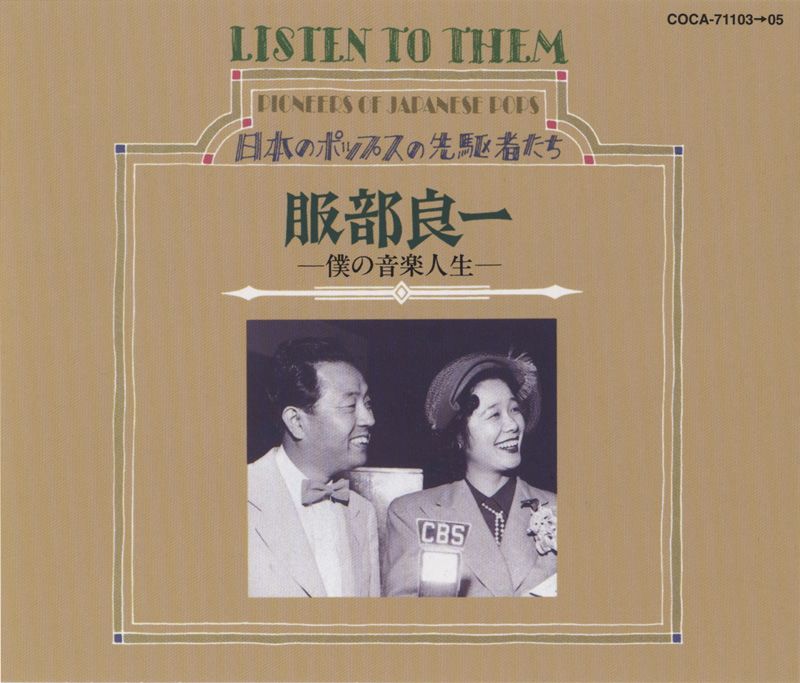 Hattori Ryōichi (1907–93), whom many regard as the father of Japanese pop music, was noted for such hits as “Tokyo Boogie Woogie” and “Ginza kankan musume” (Ginza Can-can Girl) that boldly incorporated the latest Western pop music styles and jazz rhythms. (Nippon Columbia 2006)
Hattori Ryōichi (1907–93), whom many regard as the father of Japanese pop music, was noted for such hits as “Tokyo Boogie Woogie” and “Ginza kankan musume” (Ginza Can-can Girl) that boldly incorporated the latest Western pop music styles and jazz rhythms. (Nippon Columbia 2006)
“Tokyo Boogie Woogie,” composed and arranged by Hattori Ryōichi and performed by Kasagi Shizuko, is likewise viewed as the musical embodiment of postwar Japanese culture under the US Occupation (1945–52). The swinging, decidedly Western rhythm of Hattori’s music seems to epitomize the postwar Japanese love affair with American culture, and the image of singer Kasagi Shizuko shimmying about recalls the risqué dancing of the “pan-pan girls” who made a living soliciting US servicemen. Such associations make it easy to imagine that “Tokyo Boogie Woogie” sprang fully formed from the unique cultural ambience of postwar Japan. But the truth is that both Kasagi and Hattori were key figures in the development of Japan’s prewar jazz culture. In fact, prewar Japanese jazz reached its zenith just before the outbreak of war with the United States with the musical theater troupe formed by Kasagi and Hattori (Shōchiku Gakugekidan).
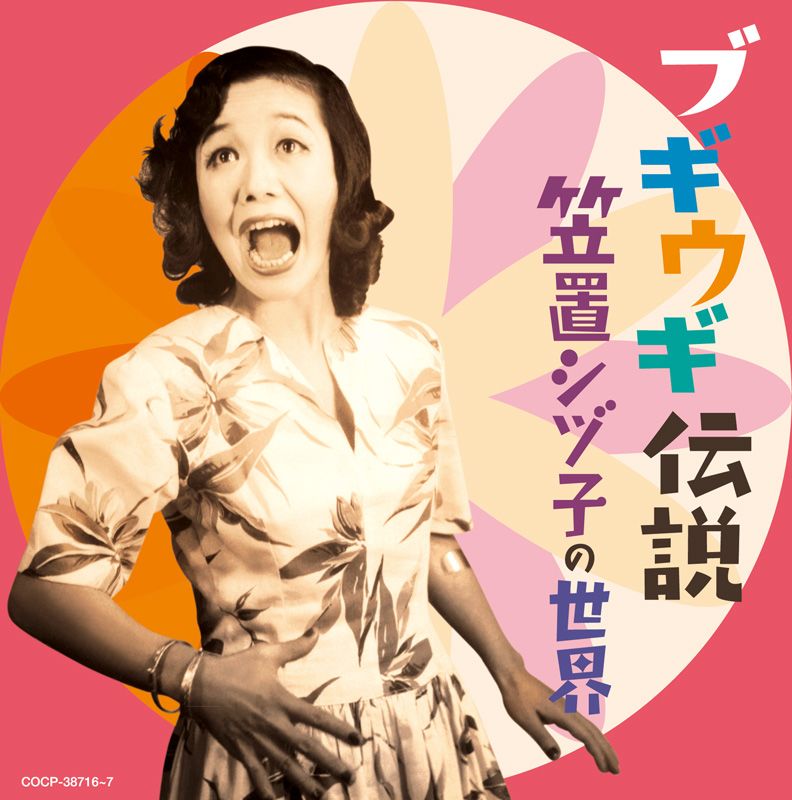 Kasagi Shizuko (1914–85), known as the “queen of boogie” in early postwar Japan. Kasagi was born in Kagawa Prefecture. At the age of 13, she joined the all-women’s musical theater troupe that was to gain fame as the Osaka Shōchiku Kagekidan and quickly attracted notice for her dynamic stage presence. After her 1947 hit single “Tokyo Boogie Woogie,” she released a string of similar titles, including “Jungle Boogie,” “Homerun Boogie,” and “Shopping Boogie.” (Nippon Columbia, 2014)
Kasagi Shizuko (1914–85), known as the “queen of boogie” in early postwar Japan. Kasagi was born in Kagawa Prefecture. At the age of 13, she joined the all-women’s musical theater troupe that was to gain fame as the Osaka Shōchiku Kagekidan and quickly attracted notice for her dynamic stage presence. After her 1947 hit single “Tokyo Boogie Woogie,” she released a string of similar titles, including “Jungle Boogie,” “Homerun Boogie,” and “Shopping Boogie.” (Nippon Columbia, 2014)
Boogie rhythms first appeared in Hattori’s work not after but during the war, when the composer was stationed in China for the purpose of staging propagandist musical reviews. The new rhythm appears in a section of Hattori’s symphonic jazz composition “Night Fragrance Fantasia,” which premiered at a recital in Shanghai in June 1945.
As an aside, in the 1960s, when Hattori’s popularity was on the wane, he forged a new career path for himself in Hong Kong, where he had a tremendous influence on the development of the local entertainment industry. Hattori’s career thus embodies the continuity and interconnectedness of East Asian popular culture in the prewar and postwar eras.
Spurned by the Intelligentsia
Of course, one could scarcely expect that the very first hits of postwar Japan would emerge from a vacuum, disconnected from the performers, composers, and styles of the preceding periods. But this continuity was problematical from the standpoint of the progressive postwar intellectual elite, which hoped to propagate a postwar culture embodying enlightened, democratic ideals. Critics attacked the new pop music as retrograde and reactionary, an attitude encapsulated in this comment by Sonobe Saburō, one of the most prominent music critics of the time.
“Consider the recent pop song [ryūkōka] ‘Ringo no uta.’ Is there a single line in this song’s lyrics that speaks to the inner life of the common man? Or that expresses genuine human emotion, for that matter? It is nothing but a string of meaningless words put to an equally vapid melody, paired with a performance whose musical-revue ambience panders to the masses’ fascination with foreign culture. In a time of desolation and ruin, when the people fall prey to a hopeless and unreflective state of mind, commercialism is cynically exploiting their weakness and lack of self-awareness and plunging them into a state of lethargy as it revives the tendencies of the old liberalism's twilight years. (Sonobe, Minshū ongaku ron [Music for the People, 1949], p. 35).
A similar hostility toward so-called ryūkōka—the commercial popular music favored by the Japanese recording industry—surfaced in the 1950s among leftist circles with the rise of the sing-along movement and the activities of the Workers’ Music Council. This reaction had a significant impact on Japan’s music scene in the decade spanning the mid-1950s and mid-1960s.
Another illustration of our changing perceptions of early postwar pop music bears mention. Film director Imai Tadashi, a leftist intellectual known for his social realist approach, objected to the theme song Hattori penned for his 1949 film Aoi sanmyaku (Blue Mountain Range) as being a typical ryūkōka. However, the song, with the beginning line “wakaku akarui utagoe” (cheerful young voices), took its place as an anthem of vibrant youth.Yet the song later came to symbolize postwar democracy in the popular imagination. In two opinion polls conducted by television networks in the 1980s (TBS in 1981 and NHK in 1989), it came in first place among “songs that the Japanese people love best.”
NHK’s Amateur Singing Revolution
In later years, the measure of a song’s popularity would be the number of singles it sold, but at the time when “Ringo no uta” came out, precious few people had money to spend on records, and in any case, the record pressing plants had been damaged by air raids and materials were in short supply. Instead, the song spread and took hold through a characteristically “postwar” route—namely, the phenomenally popular radio program Nodo jiman (Amateur Singing Contest). Contestants sang the song over and over, until practically everyone in the country was humming along.
Nodo jiman premiered on the NHK (Japan Broadcasting Corporation) radio network in January 1946, not long after regular radio broadcasts resumed, and it quickly became a nationwide sensation. Interestingly, the idea for the program came in response to a directive from the administrative headquarters of the US Occupation forces, popularly known as GHQ, to democratize radio broadcasting. The idea of broadcasting the mediocre voices of ordinary amateurs over the public airwaves was unprecedented in Japanese radio, which had evolved as a strictly top-down medium. To many, it seemed the very essence of the new democracy.
But Nodo jiman also had its roots in wartime memories. Apparently the show’s originators got the idea for an amateur hour from the talent shows that the Japanese troops would stage for their own entertainment during the war. It also bears noting that the reason so many people could listen to the program was that radio had spread rapidly during the war as a vital tool for communicating and receiving government information regarding air raids, rations, troop deployments, and so forth.
Be that as it may, the impact of Nodo jiman spread far beyond broadcasting. Amateur singing competitions soon took hold as a new and popular form of entertainment, off the air as well as on. Record labels jumped on the bandwagon by holding open auditions for recording contracts, a practice that gave birth to such stars as Shimakura Chiyoko, Kitajima Saburō, and Miyako Harumi. This was a radical step for an industry in which new recording contracts had previously been reserved for music school graduates and protégés of established singers and composers. This active effort to tap the talent of amateurs—paralleled by the movie studios’ search for “new faces”—became a potent symbol of the postwar democratic spirit.
Misora Hibari and Other NHK Rejects
One performer who arrived on the scene as the very embodiment of the Nodo jiman era was Misora Hibari, a representative postwar singer who is frequently described as the “most authentic” Japanese pop star. Here was a little girl of humble origins who started out entertaining her fish-seller father in Yokohama. She quickly made her mark on the stage, and then went on to a fabulously successful career in recording and cinema as the early postwar era’s biggest superstar.
Indeed, the title of the 1949 film in which Hibari made her juvenile motion picture debut was Nodo jiman kyō jidai (The Amateur Hour Age). In that movie, Hibari flaunted her precocious talents by performing Kasagi Shizuko’s hit “Tokyo Boogie Woogie” with a sophistication and flair few adults could rival. (The headline of an enthusiastic newspaper article by Hibari booster Satō Hachirō—the man responsible for the lyrics of “Ringo no uta”— dubbed her the “boogie woogie kid.”)
Ironically, the producers of the original Nodo jiman deemed Hibari’s style totally unsuitable. In a competition where one or two bells signaled elimination, the young Hibari received no bells at all and failed to advance past the preliminaries. In a magazine article published after she became a big star, NHK’s musical director Maruyama Tetsuo (brother of political scientist Maruyama Masao, a prominent champion of postwar democracy) was quoted as saying, “I wouldn’t ring the bell for the Misora Hibari of today if she were to appear on Nodo jiman.”
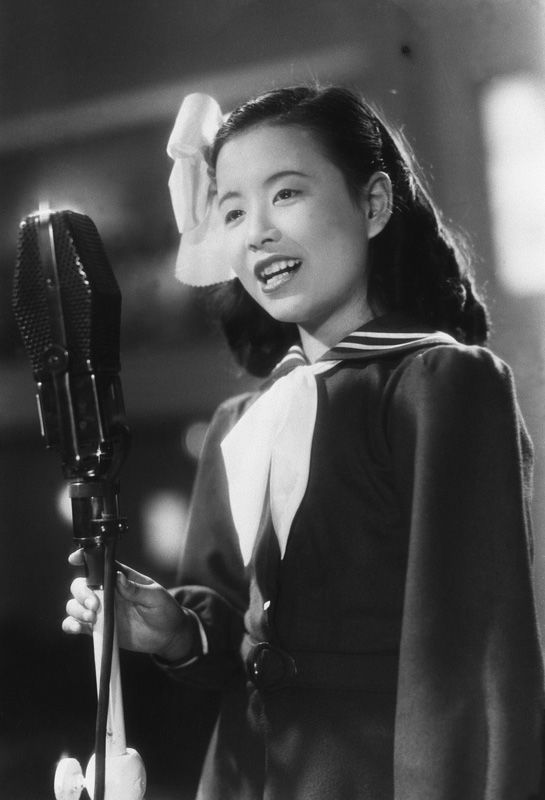 Misora Hibari (1937–89) as a child star, singing her 1949 hit “Kanashiki kuchibue” (Sad Whistling), which sold a half million records. (Jiji)
Misora Hibari (1937–89) as a child star, singing her 1949 hit “Kanashiki kuchibue” (Sad Whistling), which sold a half million records. (Jiji)
The episode illustrates a lesser-known side of NHK’s Nodo jiman. In addition to being a popular program that launched a craze for amateur singing and a new form of popular entertainment, it was also a vehicle for promoting the network’s musical agenda. The presence of such an agenda also explains why hits like “Tonko-bushi,” representing a distinctively Japanese genre associated with drinking parties, never aired on the program during the early 1950s despite their tremendous surge in popularity around that time.
NHK’s musical preferences were clearly reflected in the kinds of songs performed by the winners of Nodo jiman. For the most part, these were wholesome, decorous songs in the Western tradition of parlor music or lied, sung in an appropriately genteel Western manner. Many, indeed, were rajio kayō (radio songs), songs written expressly for NHK’s popular music broadcasts.
The truth is that from the beginning, public broadcasting in Japan set itself in opposition to the kind of commercial mass entertainment that began to make serious inroads in Japan in the late 1920s with the rise of the record and movie industries. In an effort to counter what it viewed as vulgar and corrupting influences, the national broadcasting service began to develop and promote its own distinct brand of popular music, one that it considered more respectable, elevated, and family oriented.
The very term kayōkyoku, sometimes translated “standard Japanese pop,” came about as an attempt by the broadcasting service to distinguish its brand of popular music from the ryūkōka that the record companies were promoting. This was the beginning of a long campaign that took various forms over the decades. The so-called kokumin kayō (national songs) that first began to air in 1936 soon morphed into senji kayō (“wartime songs”). The rajio kayō of the postwar years were essentially kokumin kayō with a different label. In the early 1960s, the TV variety show Yume de aimashō (I’ll See You in My Dreams), with its influential “song of the month” segment, nurtured such wholesome hits as “Ue o muite arukō” (released in the United States as “Sukiyaki”), “Tōku e ikitai” (I Want to Go Far Away), and “Konnichi wa akachan” (Hello, Baby). The NHK program Minna no uta (Songs for Everyone) performs the same function today.
Miki Torirō’s Crusade
The single most influential figure in the development of this radio-driven genre of postwar pop was the songwriter Miki Torirō. The Tokyo-born son of an attorney, Miki studied in the Faculty of Law of the elite Tokyo Imperial University (today’s University of Tokyo), where he pursued his musical interests as a minor, studying composition under Moroi Saburō. Upon graduation he took a job with Nissan Chemical Industries before being called to war. As a member of the educated elite, he served as a paymaster in the Imperial Army. After the war, he decided to pursue music as a profession. Leveraging his relationship with Moroi Saburō, he visited the offices of NHK bearing his song Minami no kaze ga kiechatta (The South Wind Is Gone) about life in the bombed-out ruins of Tokyo. Music director Maruyama Tetsuo liked the piece so well that he had it played over the radio the very same day. It was an instant hit.
Miki’s first regular program on NHK, Uta no shinbun (Singing Newspaper), fell afoul of the GHQ censors and was canceled. But in 1947 the network launched the weekly Nichiyō goraku ban (Sunday Entertainment Edition), which included Miki's segment Jōdan ongaku (Musical Jokes), consisting of comedy routines built around news items and anecdotes and interspersed with his own music. Jōdan ongaku garnered a huge following during the Occupation years with its combination of lilting music and biting satire (the latter directed primarily at the Japanese government—never GHQ, which was off-limits). During this time Miki composed a spate of songs, such as Boku wa tokkyū no kikanshi de (I’m a Special Express Engineer), Doku kesha iranka ne (Won’t You Buy My Remedy?), and Inaka no basu (The Rural Bus), that quickly caught on among the populace—sometimes without the benefit of a hit record—thanks to the medium of radio.
 Miki Torirō (1914–94), a pioneer of the radio musical variety show and a major force in the early postwar development of Japanese popular music. Miki’s satirical comedy and music segment on NHK’s Sunday Entertainment Edition catapulted him to fame in the late 1940s. Following the advent of commercial broadcasting in 1951, he emerged as the era’s most influential writer of advertising jingles. (Nippon Columbia, 2005)
Miki Torirō (1914–94), a pioneer of the radio musical variety show and a major force in the early postwar development of Japanese popular music. Miki’s satirical comedy and music segment on NHK’s Sunday Entertainment Edition catapulted him to fame in the late 1940s. Following the advent of commercial broadcasting in 1951, he emerged as the era’s most influential writer of advertising jingles. (Nippon Columbia, 2005)
After the Occupation ended in 1952, Nichiyō goraku ban was canceled under pressure from the Japanese government, and Miki left NHK to work in the new field of commercial broadcasting. His biggest contribution during this period was a huge body of advertising jingles, including such classics as “Boku wa amachua kameraman” (I’m an Amateur Photographer), widely considered Japan’s first commercial ditty; “Wa wa wa, wa ga mitsu” (Wa Wa Wa, Three Rings; for Mitsuwa Soap); “Kirin Lemon”; “Akarui Nashonaru” (Bright National); and “Kushami sankai Ruru sanjō” (Three Sneezes, Three Rurus).
Miki Torirō’s switch from political satire to commercial jingles may look like a sell-out. But the fact is that for Miki, satire had never been anything more than a way of getting people to listen to his music with the ultimate aim of elevating the musical tastes of the masses. From beginning to end, his self-appointed mission was to spread his brand of cheerful, “good quality” pop music (quality being the sense of consistency with the rules of polite Western music) to every household in the nation through the medium of broadcasting, so as to rescue the tastes of the common people from the toxic vulgarity of mass culture in its earlier incarnation.
Through his work, Miki Torirō helped foster among the Japanese the perception that music aired by the broadcast media was not only more elevated than the commercial music disseminated by records and motion pictures but also more accessible. This may be one reason so many Japanese pop hits over the years have been tied in with TV programs and advertising campaigns.
Impact of the US Bases
Miki Torirō’s musical orientation was in part a product of the Western musical education he received before the war, but another important influence was the music broadcast by the US Armed Services radio during the Occupation. The complex, rich orchestration and sophisticated background vocals of America’s big bands provided him with a model for high-quality popular music. In fact, before he began working exclusively for NHK, Miki had been performing for the US troops in Japan.
In the immediate postwar period, a considerable number of Japanese musicians made a living providing American-style entertainment at nightclubs and other establishments catering to members of the US military. This parallel universe thrived in close proximity to the Japanese pop scene that we have examined thus far, though it was remote from the everyday experience of the average Japanese.
As the Occupation drew to an end, the singers who had launched their careers in those nightclubs began to direct their efforts toward Japanese audiences. Heading the list were Chiemi Eri and Yukimura Izumi, who were both the same age as Misora Hibari. The media crowned Hibari, Chiemi, and Izumi the Three Sisters of Japanese pop music.
The “entertainment production” companies (Japanese-style talent agencies) that have played such a dominant role in the Japanese entertainment industry since the 1960s—serving not only as agents, managers, and publicists but also as incubators for new talent—evolved from the activities of the entrepreneurs who carved out a living managing bands and booking acts to keep the Occupation forces entertained. Until then, impresarios were attached to specific locales and venues, and a single manager or lackey was the most an entertainer could hope for in the way of personal staff.
After the Japanese “rockabilly” craze of 1958, talent agencies were eager to sign young performers to appear on the new medium of TV and give their impression of American rock and roll. By the late 1960s, the old structure of the Japanese entertainment industry, rooted in the vertical integration of the motion picture and record businesses, had given way to a completely new scene dominated by television and a few powerful talent agencies. But any detailed discussion of this phase will have to await another opportunity.
Individual and Collective Memory
In the foregoing, I have tried to provide a brief analysis of the popular music scene in the early postwar era from the standpoint of prewar and wartime linkages, the media environment, and ideological influences. In doing so, I have deliberately emphasized circumstances that clash with the prevailing image of postwar popular music, including the sharp criticism directed at certain songs, people, and phenomena that we now associate with the spirit of the nation.
Needless to say, the foregoing is a selective presentation reflecting my own focus and interpretation. I do not claim any monopoly on historical truth. My primary aim has been to show, first, that popular music did not undergo a total transformation immediately after the war, as many people assume; and second, that some of the best-known and best-loved songs of the postwar era did not enjoy universal acclaim at the time.
Songs are an inextricable component of our individual memories of a given era. And certain songs may become an index of the collective memory of that era. But the formation of a collective memory out of our individual memories is the result of a complex interaction of cultural and political influences at each stage along the way, as suggested by the transformation of songs like “Ringo no uta”—which many influential critics found repulsive at the time—into positive symbols of the era as a whole and the people who lived through it. Moreover, the collective memory is forever being revised and updated. As the Japanese people take stock of the last seven decades, who knows what new version of postwar pop music history will emerge from the process?
(Originally published in Japanese on June 30, 2015. Banner photos courtesy of Nippon Columbia and Jiji.)
postwar music NHK GHQ Hattori Ryoichi US Occupation Misora Hibari Jazz